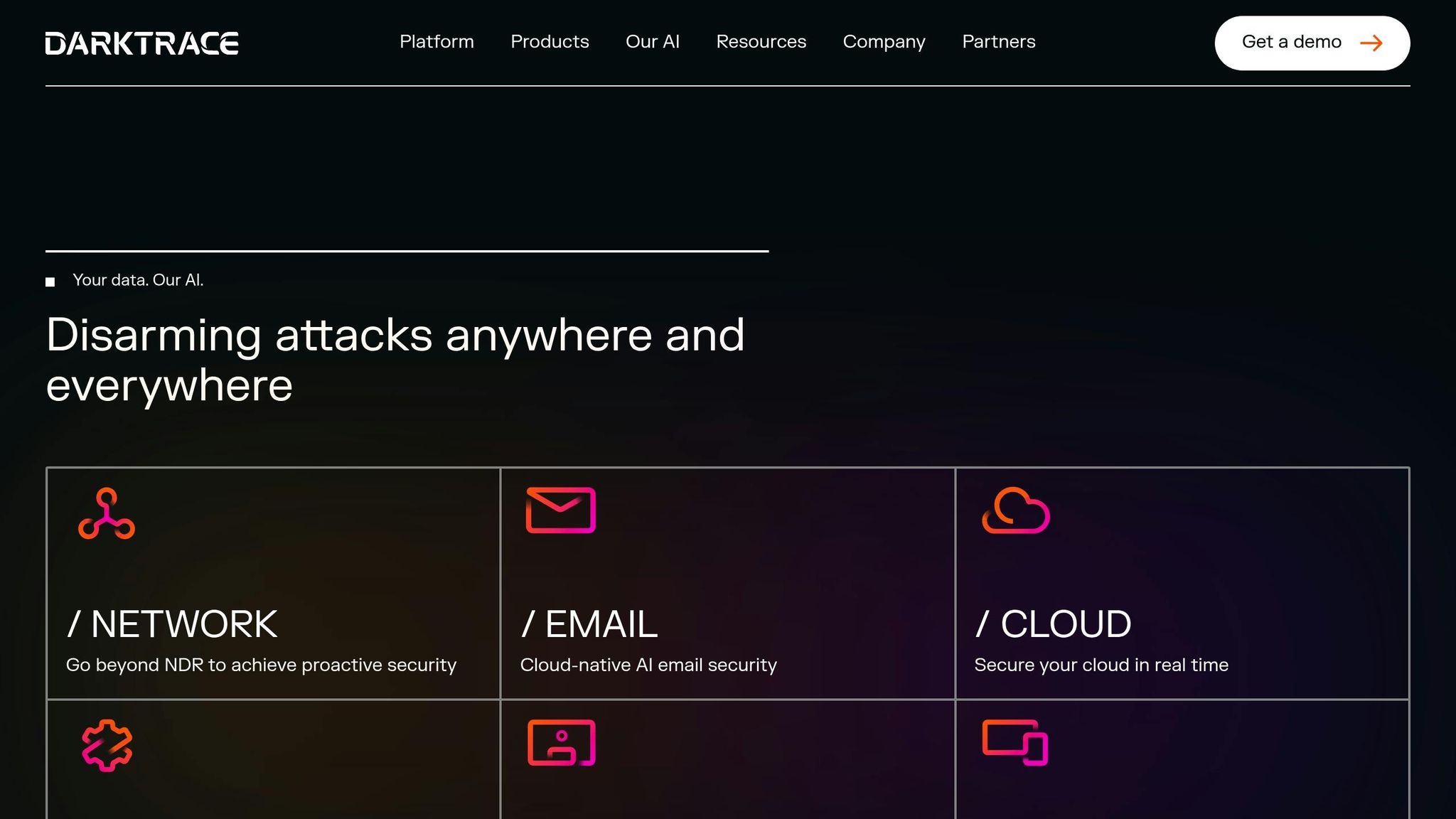Top AI Tools for Securing Voice Commerce

Voice commerce is growing fast, but it comes with serious security risks like voice spoofing, fraud, and data breaches. AI tools are stepping in to help. Here's a quick look at how AI is making voice commerce safer:
- Voice Biometrics: Uses unique vocal patterns for authentication, reducing fraud by up to 90%.
- AI-Powered Fraud Detection: Identifies suspicious behavior in real-time, even against advanced threats like deepfake audio.
- Secure Voice Data Transmission: Protects sensitive information with AI-enhanced encryption and multi-factor authentication.
- Blockchain Integration: Adds transparency and security to voice transactions.
- Machine Learning: Adapts to new threats, detecting fraud faster and more accurately.
Key Tools to Consider:
- Dialzara: AI-powered call handling with encrypted data and phishing protection.
- CrowdStrike Falcon: Monitors endpoints for unusual activity.
- Darktrace Antigena: Self-learning AI that detects and neutralizes threats in real-time.
As voice commerce grows, adopting AI security tools is essential to protect transactions and customer trust.
Core AI Technologies for Voice Commerce Security
Voice commerce security relies on three key AI technologies: voice biometrics, AI-powered fraud detection, and secure voice data transmission. Each plays a vital role in addressing vulnerabilities and protecting against fraud and unauthorized access.
Voice Biometrics for User Authentication
Voice biometrics uses over 100 vocal characteristics - like pitch, tone, cadence, and pronunciation - to create a unique voiceprint for each user. This approach surpasses traditional methods like passwords or PINs. It can operate in two modes: active (requiring a specific passphrase) or passive (analyzing natural conversation), offering secure and seamless authentication.
"Voice biometrics isn't just another tech buzzword; it's a game-changing solution transforming security, customer experience, and business operations across industries." – Geeta Gupta, Head of AI and Data Sciences, Wink
Voice biometrics can reduce fraud in high-risk transactions by up to 90%. It also combats advanced threats like deepfakes, which could cause losses exceeding $250 million annually by 2027. By continuously monitoring speech patterns during conversations, the system adds an extra layer of security without interrupting the user experience. Additionally, it can identify known fraudsters by comparing voices against a database of flagged individuals.
To further reinforce security, voice biometrics works alongside AI-powered fraud detection systems.
AI-Powered Fraud Detection
AI-powered fraud detection analyzes voice characteristics, speech patterns, and behavioral biometrics in real time to differentiate genuine users from potential threats. It evaluates subtle cues like tone, speech speed, pauses, and conversational flow, which can reveal signs of stress or urgency often linked to fraudulent activity. Beyond voice analysis, the system examines customer behavior, account linkages, and transaction patterns to detect similarities with known fraudulent profiles.
What makes these systems particularly effective is their ability to learn and adapt. Machine learning allows them to recognize new fraud tactics, including sophisticated impersonation techniques like deepfake audio. This adaptability is critical as cybercriminals increasingly leverage AI for advanced scams.
The financial impact of AI-powered fraud detection is undeniable. For instance, PayPal enhanced its real-time fraud detection capabilities by 10% while cutting server capacity needs by nearly eightfold using NVIDIA GPU-powered inference. Similarly, Rakuten France deployed AI systems to counter intelligent bots, allowing technical teams to focus on other priorities while the system handled threats in real time.
Beyond reacting to fraud, these systems can take a proactive stance. They can alert businesses to potential risks before they escalate, enabling preventive action.
Secure Voice Data Transmission
In addition to authentication and fraud prevention, secure voice data transmission is crucial for safeguarding sensitive information during transactions. Voice commerce often involves personal and payment details, making robust protection essential.
AI-enhanced encryption, paired with multi-factor authentication, ensures data remains secure during transmission. With Gartner predicting that 30% of browsing sessions will be screenless by 2025 and AI expected to power 95% of customer interactions by then, maintaining strong data security is more important than ever.
Top AI Tools for Voice Commerce Security
With voice commerce fraud impacting 16% of consumers in 2023 and more than 28% of unknown calls being classified as spam or fraud, businesses must adopt AI-driven solutions to safeguard voice-based transactions and communications.
Dialzara

Dialzara is an AI-powered virtual phone answering service that combines advanced call management with strong security features. It offers 24/7 automated call handling with built-in protections, including encrypted data transmission to secure sensitive customer information. Its phishing protection tools screen callers, manage client intake, and collect data under strict security protocols.
Capable of handling multiple calls at once, Dialzara integrates with over 5,000 third-party applications, ensuring secure voice operations across your tech ecosystem. The platform also records and transcribes all interactions, providing a detailed audit trail for compliance and monitoring. Pricing starts at $29/month for 60 minutes, $99/month for 220 minutes, and $199/month for 500 minutes. Each plan includes toll-free or local phone numbers, email and text notifications, and customizable FAQ features.
This comprehensive call security system is further reinforced by AI tools focused on endpoint and behavioral protections.
CrowdStrike Falcon

CrowdStrike Falcon specializes in AI-powered endpoint protection, using behavioral analytics and machine learning to detect suspicious activities that traditional tools might miss. By continuously monitoring endpoint data, Falcon identifies unauthorized access attempts and unusual data transfers. For example, financial giants like Mastercard and Visa use similar AI systems to analyze user behavior, location, and transaction history - blocking fraudulent activities within milliseconds.
Darktrace Antigena

Darktrace Antigena takes a different angle on security, leveraging self-learning AI to create a robust framework for voice commerce environments. Using unsupervised machine learning, it establishes a "pattern of life" for every user and device, detecting subtle anomalies that could signal insider threats, advanced malware, or persistent cyberattacks. With autonomous response capabilities, Antigena can neutralize threats in real time - often acting faster than human analysts can respond.
New Trends in Voice Commerce Security
As voice commerce grows, so do the challenges of keeping transactions secure. Thankfully, cutting-edge technologies are stepping up to tackle these threats. Two key approaches are making waves in safeguarding voice-based interactions.
Blockchain Integration for Voice Transactions
Blockchain technology is proving to be a game-changer for securing voice transactions. By using cryptographic algorithms, blockchain creates records that can’t be tampered with. This means voice commands and transactions are locked in as they happen, ensuring both transparency and security.
When paired with voice AI, blockchain takes things further by enabling secure purchases and identity verification through voice recognition. Add voice biometrics to the mix, and it becomes even harder for unauthorized users to gain access. As noted by iWeb:
"Blockchain ensures that every transaction is secure and transparent. This is crucial for voice commerce, where users need to trust that their voice commands will be executed correctly." - iWeb
Despite its complexity - requiring expertise in cryptography and decentralized systems - blockchain’s potential is hard to ignore. With voice shopping projected to hit $50 billion in the U.S. market, businesses are investing heavily in these secure infrastructures. Blockchain’s role complements AI-driven detection methods, forming a robust defense for voice commerce.
Machine Learning for Adaptive Threat Detection
On the other hand, machine learning (ML) is transforming how voice commerce systems stay ahead of fraud. These algorithms learn from data and adapt in real time, making them highly effective against evolving threats.
The numbers tell a compelling story: the AI and ML security market is expected to grow from $22.4 billion in 2023 to around $60.6 billion by 2028. This growth is fueled by rising eCommerce fraud losses, which reached $41 billion in 2022 and climbed to $48 billion in 2023. ML systems can process vast amounts of audio data to detect subtle signs of voice cloning, instantly flagging suspicious activity. This is crucial, as human error and compromised credentials were responsible for 74% of breaches, according to Verizon's 2023 Data Breach Investigations Report.
Companies are already leveraging ML to great effect. Rakuten France used AI-driven fraud detection to fend off bot attacks, freeing up their tech teams for other priorities. BlaBlaCar also turned to ML-powered tools to secure its large user base without sacrificing functionality. A particularly promising trend is federated learning, which lets AI models train on distributed data without centralizing sensitive information, boosting both privacy and threat detection.
As FBI Special Agent Robert Tripp highlights:
"As technology continues to evolve, so do cybercriminals' tactics. Attackers are leveraging AI to craft highly convincing voice or video messages and emails to enable fraud schemes against individuals and businesses alike." - FBI Special Agent in Charge Robert Tripp
With blockchain and machine learning working hand in hand, the future of voice commerce security looks far more resilient against the ever-changing tactics of cybercriminals.
sbb-itb-ef0082b
How SMBs Can Implement AI Security Tools
For small and medium-sized businesses (SMBs), adopting AI security tools isn't just about keeping threats at bay - it's about finding solutions that bring real, measurable value. However, limited budgets and IT resources often make this process a bit more challenging.
To make the most of AI, think of it as an ongoing investment that builds on a secure IT foundation. Robin Patra, Head of Data, Platform, Product, and Engineering at ARCO Construction, sums it up well:
"Without clear ROI, AI initiatives risk becoming costly experiments rather than value drivers."
Start by ensuring your systems are secure and fully optimized. Then, make sure the AI tools you choose integrate seamlessly with your existing systems.
Checking Tool Compatibility
Before diving in, define your security goals and evaluate how well potential tools fit into your current setup - whether it's your voice commerce platform, CRM, or inventory systems. Tools that don't integrate well can lead to data silos and inefficiencies.
Opt for solutions that can scale as your business grows. For instance, a tool that handles 100 daily voice transactions today should be able to manage 1,000 tomorrow without requiring a complete overhaul.
Ease of use is another critical factor. Even the most advanced AI security tools lose their value if your team struggles to operate them. Look for tools with intuitive interfaces that require minimal training.
Finally, choose vendors that offer robust support. Comprehensive training, responsive customer service, and clear incident response plans can make a world of difference when issues arise.
Measuring ROI on AI Security Investments
Once you've confirmed compatibility, the next step is measuring your return on investment (ROI). Tracking ROI not only justifies your spending but also highlights areas for improvement. For example, nearly 90% of customer service teams report faster complaint resolution and better call volume management with AI tools.
A thorough cost-benefit analysis should account for implementation costs, ongoing maintenance, labor savings, and measurable improvements in customer experience and operational efficiency. Take chatbots as an example: deflecting 60% of 15,000 monthly interactions can lead to an ROI of over 370%, demonstrating the tangible value of AI security tools.
Broader industry data backs this up. Chatbot services can cut service costs by 30%, and businesses often see sales increase by 67% after implementing them.
To gauge success, track key performance indicators (KPIs) that align with your business goals. Metrics like containment rates, average handle time, customer satisfaction scores, and first contact resolution rates provide clear insights into your tools' effectiveness.
Customer experience metrics are equally important. Keep an eye on your Net Promoter Score (NPS), repeat purchase rates, and overall customer satisfaction. These metrics reveal how your AI initiatives impact long-term customer relationships. After all, 71% of consumers expect personalized interactions, and 76% feel frustrated when they don’t get them.
Robin Patra underscores the importance of tracking results:
"Enterprises that measure, track and act on AI ROI will unlock sustained competitive advantages."
Regular monitoring is key. Test for bias in your AI systems using diverse training data, and run accuracy checks as your models evolve. This proactive approach can catch small problems before they grow into major vulnerabilities.
If the technical side feels overwhelming, consider teaming up with a third-party provider. They can manage the complexities of integration, freeing you to focus on measuring results and improving performance. Plus, their expertise often leads to faster ROI.
Conclusion
Voice commerce is reshaping how businesses engage with customers, but it comes with a pressing need for strong security measures. In 2023, the global voice commerce market reached a value of $42.75 billion and is projected to grow at an impressive annual rate of 24.6% through 2030, underscoring the importance of safeguarding this rapidly expanding space.
The integration of AI has not only enhanced customer experiences - 74% of U.S. shoppers report noticeable improvements - but also slashed customer service costs by 32%. These benefits present a clear advantage for businesses willing to embrace the necessary technologies .
Key tools like voice biometrics, AI-powered fraud detection, and encrypted data transmission form the backbone of voice commerce security. A standout example is Dialzara, which combines voice authentication and caller screening while integrating with over 5,000 applications. This approach has helped businesses cut operational costs by up to 90% without compromising on enterprise-grade security.
Industries like banking and insurance are already reaping the rewards of AI-driven voice security, with reduced fraud and more efficient processes. For small and medium-sized businesses, adopting AI security solutions is no longer optional. As Rashan Dixon from Microsoft highlights, advancements in technology are leveling the playing field, enabling smaller enterprises to compete effectively.
Looking ahead, technologies like blockchain and adaptive machine learning promise to further enhance the security of voice transactions. By laying the groundwork for AI-driven security now, businesses can protect their operations while delivering a superior customer experience in this voice-first era.
FAQs
How does voice biometrics enhance security in voice commerce compared to traditional methods?
Voice biometrics provides a stronger and more dependable way to secure voice commerce transactions compared to traditional methods like passwords or PINs. By examining distinct vocal traits - such as tone, pitch, and cadence - it ensures authentication is directly linked to the individual, making it extremely difficult for fraudsters to mimic.
Passwords can be forgotten or stolen, but voice biometrics offers a solution that’s both secure and easy to use. It even has the ability to spot fraud in real time by analyzing speech patterns, significantly lowering the chances of unauthorized access. This blend of security and convenience positions voice biometrics as a leading choice for safeguarding voice commerce.
How does machine learning help prevent fraud in voice commerce?
The Role of Machine Learning in Preventing Fraud in Voice Commerce
Machine learning plays a key role in keeping voice commerce secure. By analyzing voice interactions and transaction patterns in real time, it uses advanced algorithms to spot unusual activities - like transactions happening in unexpected locations or strange voice commands. Catching these irregularities early allows businesses to flag and address potential fraud before it escalates into a bigger problem.
On top of that, machine learning enhances voice authentication systems, ensuring that only authorized users can carry out transactions. This extra layer of protection not only safeguards sensitive customer information but also helps businesses maintain trust in their voice commerce platforms.
What are some practical ways small and medium-sized businesses can use AI tools to secure voice commerce without overspending?
Small and medium-sized businesses (SMBs) can strengthen voice commerce security by using affordable AI tools that are simple to implement and don’t require extensive technical know-how. AI-driven solutions, such as virtual phone agents, can take over tasks like answering calls, verifying customer identities, and managing messages. This ensures 24/7 support while keeping sensitive data secure.
These tools often work smoothly with existing systems, making it easier for businesses to adopt advanced security measures - like multi-factor authentication - without stretching their IT budgets. By using these solutions, SMBs can enhance their security, save valuable time, and cut operational costs, all while meeting growing customer needs without sacrificing service quality.
Summarize with AI
Related Posts
AI Data Security in Telecom: 2024 Guide
Learn about the key challenges, risks, regulations, and best practices for implementing AI data security in telecom networks. Discover how AI can help detect and prevent cyber threats.
How AI Detects Fraudulent Documents in Real Time
AI revolutionizes document verification, offering real-time fraud detection, improved accuracy, and scalable security for small businesses.
AI Phone Agents with Voice Biometrics: Guide 2024
Explore how AI phone agents with voice biometrics enhance security, streamline authentication, and improve customer experiences in our comprehensive 2024 guide.
Best Practices For AI Voice Branding
Learn how AI voice branding enhances customer interactions, builds trust, and streamlines operations for businesses of all sizes.
